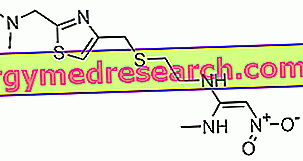
Nizatidine is an H2 antagonist developed by the pharmaceutical company Eli Lilly, which put it on the market for the first time in 1987, under the name of the Axid ® registered specialty. In 2000, the pharmaceutical company Eli Lilly announced the sale of all trade and sales rights to Reliant Pharmaceuticals.

Nizatidine is commercially available in the form of tablets sold under the names Axid ®, Zanizal, Axid Ar ®, Cronizat ® and other invented names; the active ingredient can also be found as Axid ® oral solution and Nizax ® solution for intravenous infusion.
The use of nizatidine is particularly indicated in the treatment of duodenal ulcer, gastric ulcer, gastroesophageal reflux disease, recurrent ulcers and ulcers associated with the use of Non-Steroidal Inflammatory Drugs. Nizatidine is a powerful, selective and reversible antagonist of histamine H2 receptors. Nizatidine significantly decreases the volume of hydrochloric acid secreted in the stomach and all this takes place precisely as a consequence of the inhibition of both basal and stimulated secretion of gastric acid. This drug works quickly, giving fast relief of pain caused by the ulcer. However, based on several clinical studies, nizatidine is no more effective than other histamine H2 receptor antagonists, although some parameters indicate that this molecule can be better tolerated by our body than other H2 antagonists.
Nizatidina - Posology and method of use
In the treatment of gastric ulcers caused by prolonged use of Non-Steroidal Anti-inflammatory Drugs - or when it is necessary to follow long-term therapy using NSAIDs with a high gastrolesive power - the dose of nizatidine used is 300 mg / day, that can be taken in a single administration, in the evening before going to bed, or divided into two administrations, one in the morning and the other in the evening. The duration of treatment is generally eight weeks.
The dose of nizatidine recommended in the treatment of duodenal ulcer is 300 mg / day, taken in a single administration before going to bed or divided into two administrations of 150 mg each, one in the morning and the other in the evening before bedtime. The average duration of treatment is four weeks, but can be prolonged for another four weeks if there is no complete recovery; if instead there is a complete healing of the ulcer already in the first cycle of therapy - and if the healing is confirmed by an endoscopic examination - then the treatment can be interrupted before the four weeks pass.
Also for the treatment of benign gastric ulcer the recommended dose is 300 mg / day of nizatidine, to be taken in a single administration, in the evening before going to bed, or divided into two daily administrations of 150 mg each, of which one in the morning and the other in the evening, before sleeping. The duration of treatment with nizatidine normally varies, in this case, from four to eight weeks, but it can also be less than four weeks if there is an endoscopically confirmed case of healing.
In certain special cases, when there is healing of the ulcer after a course of therapy of four weeks, it may become necessary to maintain control over gastric secretion, especially in patients who tend to have recurrent gastric or duodenal ulcers; in these cases a prolonged maintenance therapy can be followed using 150 mg / day of nizatidine, to be taken in a single administration before going to bed. This type of therapy must be closely monitored by your doctor.
In the treatment of gastroesophageal reflux disease the recommended dose is 300 mg / day of nizatidine, divided into two daily administrations, one in the morning and one in the evening, of 150 mg each. In the most severe cases an attack dose of 600 mg / day of nizatidine can be used, and then reduced as soon as possible based on the patient's personal therapeutic response.
Nizatidine is mainly excreted by the kidneys, therefore it is advisable to take special care in case of severe renal failure.
Nizatidine - Contraindications and warnings for use
Before starting treatment with nizatidine, it is essential to ensure that the symptoms for which pharmacological intervention is required are not related to a neoplastic malignant gastric ulcer; nizatidine, in fact, by masking the symptoms and relieving pain can significantly delay the diagnosis of the neoplasm. Several studies have shown that nizatidine does not interfere with the enzymatic system that metabolizes most drugs, associated with cytochrome P450, so it is unlikely that drug interactions with other drugs linked to hepatic metabolism inhibition by cytochrome P450 will occur. . However, in the event of prolonged treatment with nizatdin, medical checks must be performed on the therapeutic effect of the drug and on any side effects that may occur. Nizatidine is partially metabolized by the liver and excreted, almost ninety percent, by the kidneys; as anticipated, care must therefore be taken if patients suffering from renal or hepatic insufficiency are treated; since it is known that a large proportion of elderly patients suffer from renal insufficiency, it is advised to pay particular attention to treatment with nizatidine during senescence. In the case of patients with severe, or even moderate, renal insufficiency, a reduction in the daily dose of nizatidine is recommended.
Several large clinical trials have shown that the use of nizatidine does not compromise the ability of patients to operate machinery or drive vehicles.
Pregnancy and breastfeeding
Before starting treatment with nizatidine during pregnancy or breastfeeding, you should discuss this with your doctor to discuss the benefits and risks of such treatment. Several animal studies on the use of nizatidine during pregnancy have not shown any risk to the fetus, but unfortunately there are no controlled data and reliable studies on the use of nizatidine during human pregnancy; therefore, we recommend taking the drug in gestation only when the benefits outweigh the presumed risks. It has been confirmed that nizatidine is excreted in breast milk only in small amounts; in one study it was noted that only 0.1 percent of the dose of nizatidine taken by the mother was secreted into breast milk during the next 12 hours. In another study, the secretion of nizatidine in breast milk was studied in three mothers during 6 months of breastfeeding; the nurses were given 150 mg of nizatidine, in a single administration or divided into five doses taken at a distance of twelve hours each; the average of nizatidine secreted in milk was 96 micrograms which corresponds to 0.064 percent of the dose taken by the mother. Despite the aforementioned data, the manufacturers of the drug recommend to stop breast-feeding during the use of the drug (or vice versa, even if it is very unlikely) based on an adverse effect observed during a study on rats; practically the rat pups showed growth depression when they were breastfed by mothers treated with nizatidine. It is however necessary to underline that nizatidine is eliminated from our body almost completely after 12 hours and completely after 24 hours, therefore, in case of beginning or resuming breast-feeding after a therapy with nizatidine there is no risk for the child.
Nizatidine - Side and unwanted effects
All drugs can, in theory, cause side effects, but in most patients there are no side effects or undesirable effects. Generally, nizatidine is a drug well tolerated by our body; despite this, it too can cause a number of side effects. An interesting fact, which derives from clinical studies performed in the United States and Canada, is that most of the side effects attributed to nizatidine have nevertheless manifested themselves - in similar percentages - in patients in the control group treated with placebo. However, among the most common side effects observed when taking nizatidine are gastrointestinal ones, such as abdominal pain and diarrhea, which are the most frequent, followed by nausea, vomiting, flatulence, constipation and dyspepsia. Other side effects related to the central nervous system, such as headache, are - along with abdominal pain - the most frequent, followed by dizziness, insomnia and rarely nervousness. Finally, there are the side effects that are rarely encountered, such as dermatological (itching and skin rash), cardiovascular (short episodes of asymptomatic ventricular tachycardia), and other undesirable effects such as hypersensitivity, fever, myalgia and asthenia.



